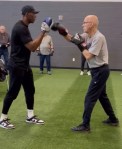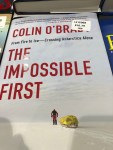
Slip right-Slip left… Jab-Cross
Slow-Slow… Quick-Quick (Foxtrot)
Can you sense it?
Duck right… Cross-Jab
Duck left… Jab-Cross
Slow… Quick-Quick, Slow… Quick-Quick (Waltz)
Do you feel it, the rhythm, the flow, the choreography?

Yes, it’s there, the melding of two precision athletic disciplines, boxing and dancing.
Jackie Chan, martial arts actor, cites iconic dancers, Fred Astaire and Gene Kelly, in an interview for Kung Fu Magazine, as two of the primary influences on his fight choreography. * Now, Chan was not a boxer but the correlation is the same. (* mentalfloss.com, Anna Green, 5/10/2017)
World heavyweight boxing champion Muhammad Ali once quipped that he “floats like a butterfly..,”. The same can be said for dance, good dancers glide on their feet, on their toes, flowing through moves, ‘like a butterfly’.
A boxing match might look like a wild affair with fast flying fists, but, like dancers, boxers use all their upper and lower body, arms and legs, in well disciplined moves, changing positions, moving their opponent (partner) while repositioning themself, back and forth, left and right, preparing for the next move, a punch combination, or for a dancer, a twinkle or turn.
Like a dancer’s steps that move to a count, the boxer’s punches have numbers, one thru six, and names to match. Watching a match with an understanding of the names, one can easily see the choreography of the punches, the combinations, the head fakes, the ‘dance’, regardless the speed.
Boxing has its ring, dancing, a floor, the arenas where boxers and dancers ply their craft with music to stimulate the action and accompany the performer.
I’ve danced socially for enough years to appreciate the athleticism of the art of dancing. an activity that is cognitively and physically challenging. The same for boxing. Both keep you thinking and moving continuously with varying changes in tempos.
My dancing was undertaken for fun and exercise, the boxing I do now is to stay fit, strong, alert, have fun, a prescription for better health.
The medical community looks approvingly on boxing as one component in a toolbox of physical activities to fend off the travails of certain ailments.
“Boxing’s varied and high-intensity workouts offer a blend of strength and cardiovascular conditioning that improves agility, coordination and balance, and which may be especially beneficial for people with neurological disorders such as Parkinson’s disease.” (NY Times, 5/23/22, Rachel Fairbank)
My punching is improving as I learn new combinations, but my footwork is sloppy. I’m not at the butterfly stage…yet.

Steve (050124)
Follow my WordPress stories at ‘srbottch.com’

